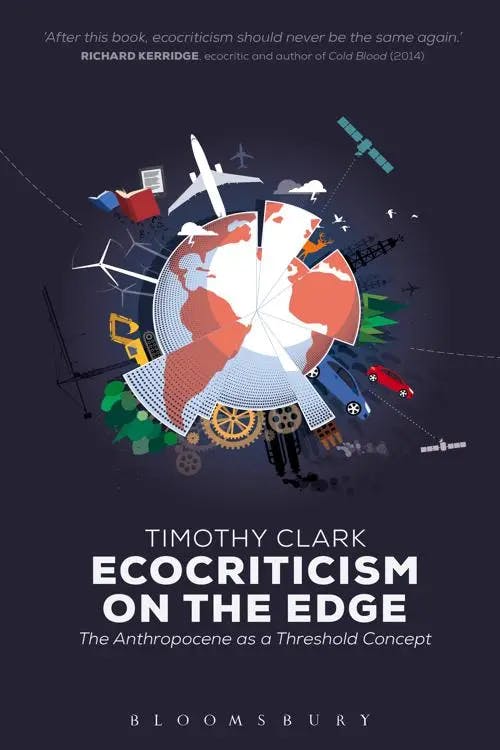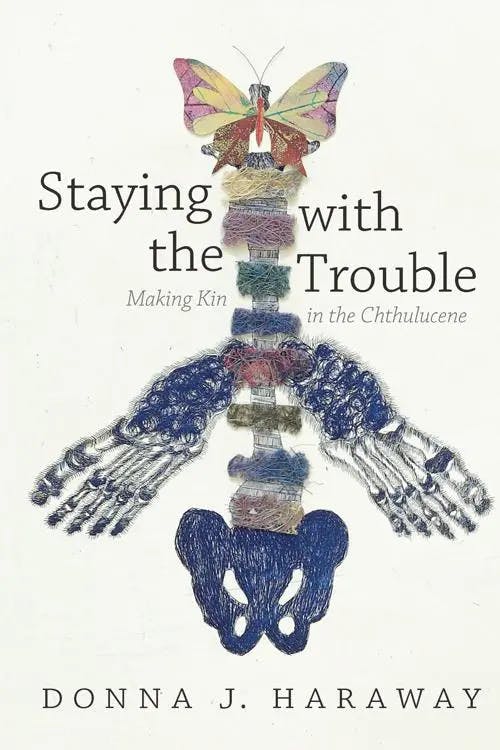What is the Anthropocene?
PhD, Environmental Humanities (University of Glasgow)
Date Published: 16.02.2023,
Last Updated: 21.02.2024
Share this article
Defining the Anthropocene
The Anthropocene, literally translated, means “the age of the human”. It is a geological term coined by Paul Crutzen & Eugene Stormer in the year 2000, used to both describe and propose a new geological era – one which marks the end of the Holocene and the start of an altogether new age. This new geological era, the so-called Anthropocene, is one marked by human influence on Planet Earth. We might think of The Anthropocene as a geological means of describing climate change – not just is the Earth’s average temperature rapidly changing, but so too are the rocks beneath our feet.
If aliens landed on Planet Earth thousands of years from now to find a planet devoid of humans, a quick look into the rock fossil record would quickly assert to the damaging presence of the human – be that in the form of a baseline level of radioactivity in the Earth, an amorphous merging of plastics into the rock fossil record, or the unprecedented amount of cattle and livestock bones enmeshed in the ground.
While originally a term used purely geologically, the Anthropocene concept has spread through the academic and public consciousness rapidly, and as such is often used to more generally describe the environmental crises of the contemporary moment. As Timothy Clark helpfully points out in Ecocriticism on the Edge: The Anthropocene as Threshold Concept,
the term has rapidly become adopted in the humanities in a sense beyond the strictly geological. Its force is mainly as a loose, shorthand term for all the new contexts and demands – cultural, ethical, aesthetic, philosophical and political – of environmental issues that are truly planetary in scale, notably climate change, ocean acidification, effects of overpopulation, deforestation, soil erosion, overfishing and the general and accelerating degradation of ecosystems. (2010)
Timothy Clark
the term has rapidly become adopted in the humanities in a sense beyond the strictly geological. Its force is mainly as a loose, shorthand term for all the new contexts and demands – cultural, ethical, aesthetic, philosophical and political – of environmental issues that are truly planetary in scale, notably climate change, ocean acidification, effects of overpopulation, deforestation, soil erosion, overfishing and the general and accelerating degradation of ecosystems. (2010)
When did the Anthropocene start?
There is much debate over when The Anthropocene started, as well as what started it. When dealing with geological time periods, assigning a precise date is rather tricky. Asking when this era started, is a bit like asking when climate change started. Was it at the birth of the steam engine? Or perhaps the colonisation of America? Does the birth of humans creating fire announce the path to our current predicament? Or, could it be at the birth of agriculture; the beginning of the pervasively accepted ideology that land is there to be neatly allotted and plundered to our own ends?
What is interesting here is not necessarily answering these questions, but in registering the rich ambiguities that lie between them. Jason W. Moore, in his book Capitalism in the Web of Life: Ecology and the Accumulation of Capital, asks, ‘Are we really living in the Anthropocene…or are we living in the Capitalocene, the historical era shaped by relations privileging the endless accumulation of capital?’ (2015, 173). Moore here suggests that not only is The Anthropocene not definable by “one” static or immutable moment, but moreover that we’re perhaps not in The Anthropocene at all – instead, we are in the Capitalocene. Critics of the term, like Moore, feel that it over emphasises the power of the human whilst erasing a sense of human responsibility. What’s more the term perhaps doesn’t reflect on the roles of capitalism, colonialism, and racism along the path that led to The Anthropocene. For instance, are all humans equally culpable for climate change? A glance at the history books would tell us that men, particularly white European men, are significantly more to blame for the effects of climate change whilst socio-geo-economically being less likely to be impacted by it. As such, other means of describing and historicising this era have arisen as a means of righting these shortcomings.
Anthropocene, Cthulucene, or Anthropocenes?
There is not a widely accepted agreement on the concept or naming of The Anthropocene within the wider academic field; indeed, Moore is not alone in his suggestion of a new name for this era. Donna Haraway is another such writer who is sceptical of the term. Haraway, within Staying with the Trouble: Making Kin in the Cthulucene, suggests the term ‘Cthulucene’ as a means of opposing the ‘exterminating forces’ of the Anthropocene and Capitalocene alike. She elaborates,
the scandals of times called the Anthropocene and the Capitalocene are the latest and most dangerous of these exterminating forces. Living-with and dying-with each other potently in the Chthulucene can be a fierce reply to the dictates of both Anthropos and Capital. (2016)
Donna J. Haraway
the scandals of times called the Anthropocene and the Capitalocene are the latest and most dangerous of these exterminating forces. Living-with and dying-with each other potently in the Chthulucene can be a fierce reply to the dictates of both Anthropos and Capital. (2016)
The Cthulu of the Cthulucene is used to describe ‘cthonic ones…beings of the earth, both ancient and up-to-the minute. I imagine chthonic ones as replete with tentacles, feelers, digits, cords, whiptails, spider legs, and very unruly hair’ (2016, 2). For Haraway, the climatic conditions of the 21st century announce a moment where it is imperative to think beyond the human. Describing this era as that “of the human”, to Haraway, is perhaps not the most useful way of forging forwards in response-ability with the non-human creatures we share the planet with. As such, Cthulucene is suggested over both Anthropocene and Capitalocene as a means of ratifying this oversight.
Through this constellation of opinions and opposing terminologies, Anthropocene, Capitalocene and Cthulucene, what emerges is not one fixed notion of The Anthropocene, but perhaps a variety of Anthropocenes. While it is important to be critical of the underpinnings and connotations of the term ‘Anthropocene’, it is also undeniable that the term itself has a heft, weight and a ubiquitous adoption beyond the world of academic study, which Haraway and Moore’s perhaps do not.
In your own reading and writing on the subject, try to be critical and mindful of which type of Anthropocene you are describing. Please see our ‘Further Reading’ list at the end of this article for more suggestions aligned to the question of what the Anthropocene is, whose Anthropocene it is, and what that particular Anthropocene might imply ethically, historically and philosophically for your research and writing.
What is “Deep Time”?
The Anthropocene concept proposes that we, humans, now occupy and influence “deep time”. Deep time is a term used to describe the timescales one would usually associate with geological periods. Where human history deals with days, weeks, months and years, geological history deals with much deeper and challenging scales. Millions of years exist as a blink of an eye in geological terms. In The Anthropocene, the distinction between human measures of history and geological measures of history start to collapse. Thus, in the Anthropocene, we begin to occupy deep time registers.
Historically human history and geological history have remained two distinctly separate fields of study. Indeed, what makes the concept of The Anthropocene so interesting as an academic field is that it breaks down such scholastic barriers. As Dipesh Chakrabarty argues in The Climate of History: Four Theses, the clashing of these two types of historical scale causes a mixing of the seemingly ‘immiscible chronologies of capital and species history. This combination, however, stretches, in quite fundamental ways, the very idea of historical understanding’ (2009, 220).
What, then, are we to do with such timescales? How can we “think” deep time and act within deep scales of time? The very way in which we understand and navigate the world is shot through with this rather alarming conflation of human scales and deep scales of time. Mobile phones are an interesting example of this type of short/deep time slippage. Not only do they require ten times more precious Earth metals than a laptop or desktop computer, but the data centres fuelling them emit large doses of carbon into the Earth’s atmosphere. As such, a mobile phone has roots in the deep geological past whilst finding itself projected into a speculative atmospheric future. All the while they are utilised for short-term, humdrum activities in the fleetingly brief present moment.
Timothy Morton’s work on Hyperobjects is interesting in relation to this deep time/human time imbrication. Morton coins the idea of ‘Hyperobjects’, suggesting they are objects that are,
massively distributed in time and space relative to humans. A hyperobject could be a black hole. A hyperobject could be the Lago Agrio oil field in Ecuador, or the Florida Everglades. A hyperobject could be the biosphere, or the Solar System’ (2013, 1). Global warming, and thus The Anthropocene, are great examples of hyperobjects, since they ‘involve profoundly different temporalities than the human-scale ones we are used to. (2013)
What is an example of the Anthropocene?
We are surrounded by examples of The Anthropocene in the day-to-day. These vary from the climactic (e.g. greenhouse gas emissions, ocean acidification, biodiversity decline, human population increase & deforestation) to the quotidian (e.g. strange weather, air travel, cattle farms & cloud data storage). Examples of The Anthropocene announce themselves both in startling headlines about climate change, but also in our day-to-day imbrication with such events; an unseasonably warm day is shot through with anxiety of the wider narrative of climate change which underpins it. In the context of these accumulating signifiers of The Anthropocene, it is interesting and instructive to explore how popular media might be both reflecting and reinforcing the unique characteristics of this era.
Science fiction films are particularly interesting in this regard. As a genre science fiction often mirrors the concerns and anxieties of the contemporary moment, per Susan Sontag’s arguments in The Imagination of Disaster. Following Sontag’s logic, as climate change has emerged as one of the biggest anxieties of the 21st century, contemporaneous science fiction films often contain Anthropocene-inflected imagery, thought and meaning.
One such example is Interstellar (Nolan, 2014). The film is set in a climate-impacted future wherein crop production has ground to a halt in a dust-bowl laden atmosphere. Humanity’s chances of survival are pinned on colonising other planets, and a band of scientists travel through a wormhole in efforts to find a suitable new home. The first planet they arrive on is particularly interesting in relation to the time-shapes of The Anthropocene. Before landing, the team discusses the temporal peculiarities of this planet – wherein every hour spent there equates to 7 years on Earth. This temporal lag poses all sorts of problems for the crew, and it leads them to note that they “need to think about time as a resource. Just like oxygen and food.” In the context of a dying planet, we do indeed need to think about time as a resource, like oxygen and food. If we do not act ecologically attentively with the little time we have left, it spells a doomsday narrative for humanity.
In their active acknowledgement of divergent temporal pressures, we see Interstellar opening a dialogue into what happens when different senses of time converge, a central preoccupation of the narrative as it unfolds and a central preoccupation of the Anthropocene as we currently understand it. In doing so, Interstellar presents the ecological time-pressure of this Anthropocene-ic situation eloquently. What’s more, when they do land on the planet, the temporal peculiarities of this uncharted territory are lent an environmental context. Mountainous waves lash down on the crew as they attempt to reach a beacon sent by their former colleagues, rendering the danger of this planet’s timeshape with a tangible environmental correlory. What’s more, to enhance the thematic preoccupation with time in the film and The Anthropocene at large, Hans Zimmer’s score enters the scene as a metronomic ticking. This ticking, initially, sounds like the dripping of water – potentially a clepsydra, or water clock. By reinforcing the visual and auditory connection between time and environmental motifs, Interstellar continually articulates its time-pressures around the environment itself. You can see this scene in the clip below:
In doing so we can see how the film is both influenced by the various collapsing time-pressures of The Anthropocene, at the same time as providing us with a platform for viewing, hearing and experiencing them; something that is perhaps harder to do in our day-to-day lives. By imbuing the collapsing time-shapes of this scene with environmental imagery and sound, Interstellar invites us to think about time from fresh environmental perspectives. As such, we might think about Interstellar as an example of ecocinema through the dialogue it opens between time, the environment and the speculative future. Through films like Interstellar we can see that cinema is a particularly useful medium for representing the various scalar discombobulations wrought through a rapidly warming climate. For more writing on cinema in relation to the environment and The Anthropocene, Robin L, Murray & Joseph K. Heumann’s Ecology and Popular Film, as well as Stephen Rust, Salma Monani & Sean Cubitt’s edited collection Ecocinema Theory & Practice are good places to start, as is the website Anthropocene Cinema.
Further Anthropocene reading on Perlego
Please see below for a suggested series of useful books for studying The Anthropocene, all available to Perlego subscribers.
- The Climate of History in a Planetary Age by Dipesh Chakrabarty
- Down to Earth: Politics in the New Climatic Regime by Bruno Latour
- The Shock of the Anthropocene: The Earth, History and Us by Christophe Bonneuil
- Dark Ecology: For a Future of Coexistence by Timothy Morton
- The Anthropocene and the Global Environmental Crisis: Rethinking modernity in a new epoch edited by Clive Hamilton, François Gemenne & Christophe Bonneuil
External resources on the Anthropocene
- https://vimeo.com/97663518 – Donna Haraway’s Lecture “Anthropocene, Capitalocene, Chthulucene: Staying with the Trouble”, 2014
- https://www.artandeducation.net/classroom/video/66320/dipesh-chakrabarty-the-anthropocene-project-an-opening – Bruno Latour’s Lecture “The Anthropocene and the Destruction of the Image of the Globe”, 2014
- https://www.youtube.com/watch?v=x00LP0QfRTk – Elizabeth Kolbert’s “The Sixth Extinction: An Unnatural History”, 2014
- https://www.science.org/content/article/are-we-middle-sixth-mass-extinction
- https://www.nature.com/articles/415023a – Paul J. Crutzen’s Geology of Mankind
What is 'The Anthropocene' in simple terms?
When did The Anthropocene start?
What is a different name for The Anthropocene?
Why does The Anthropocene matter?
Are we in the Anthropocene now?
What is an example of the Anthropocene?
Bibliography
Crutzen, P. & Stoermer, E., ‘The Anthropocene’ in IGBP [International Geossphere Biosphere Programme] Newsletter 41, 2000
Clark, T. (2015). Ecocriticism on the Edge (1st ed.). Bloomsbury Publishing.
Moore, J. (2015). Capitalism in the Web of Life. Verso.
Haraway, D. (2016). Staying with the Trouble: Making Kin in the Chthulucene. Duke University Press.
Chakrabarty, D. (2009). The Climate of History: Four Theses. Critical Inquiry, 35(2), 197–222.
Morton, T. (2013). Hyperobjects: Philosophy and Ecology after the End of the World (Posthumanities) (1st ed.). University Of Minnesota Press.
Sontag, S. The Imagination of Disaster in Commentary, vol. 40, 1965, pp. 42-48.
Murray, R., & Heumann, J. (2009). Ecology and Popular Film. State University of New York Press.
Cubitt, S., Monani, S., & Rust, S. (2012). Ecocinema Theory and Practice (1st ed.). Taylor and Francis.
Neilson, T. (2022). Anthropocene Cinema. https://www.anthropocene-cinema.com/
PhD, Environmental Humanities (University of Glasgow)
Toby Neilson has a PhD in the Environmental Humanities from The University of Glasgow. His research concerns The Anthropocene, and contemporary cinema’s relationship to it. Neilson’s research particularly focuses on science fiction films from an environmental perspective. He has lectured and published articles on ecocinema, film history, posthumanism and film philosophy.


